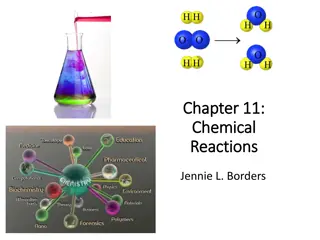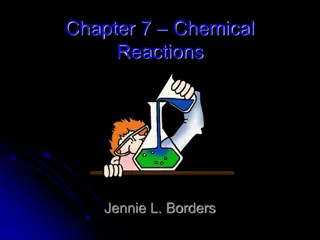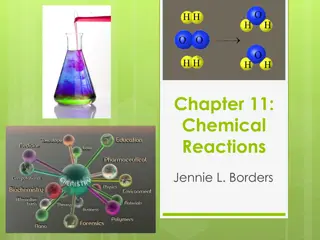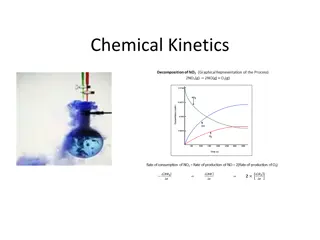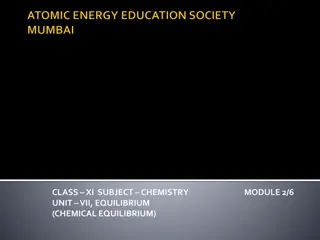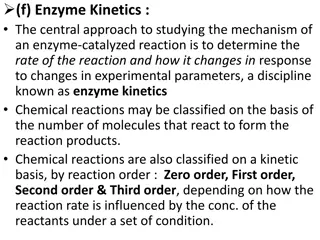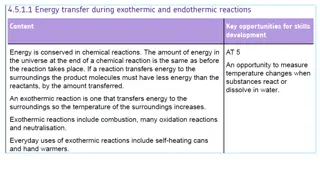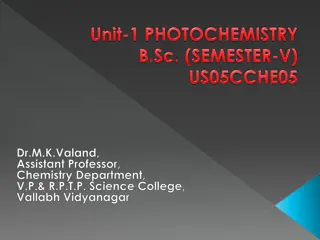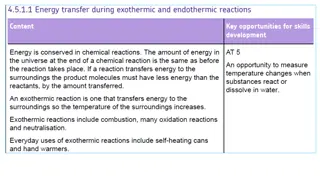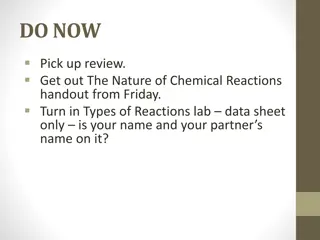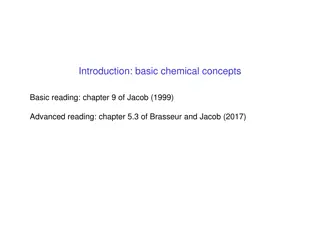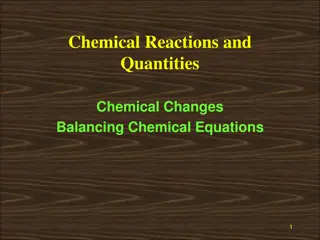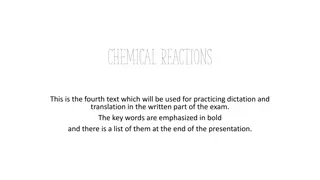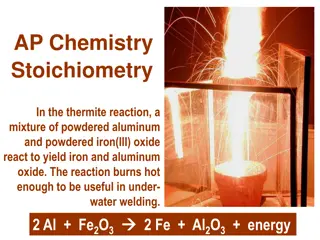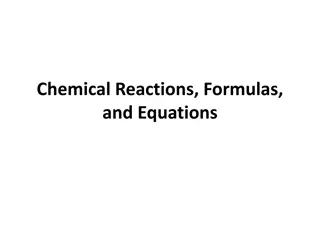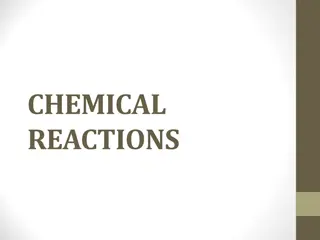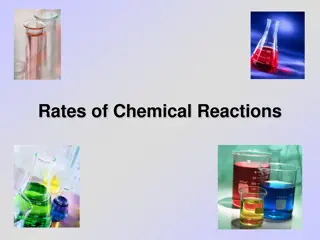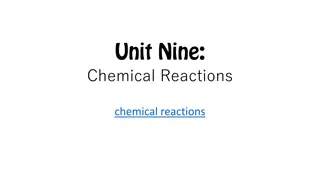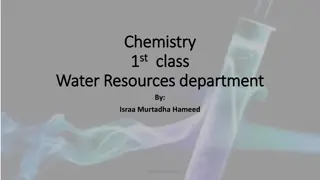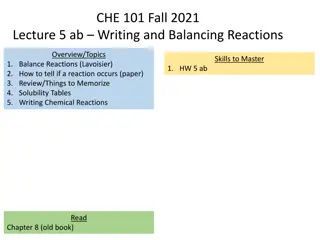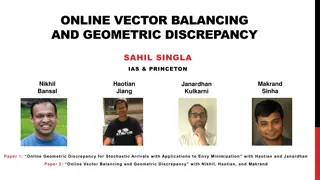
Chemical Reactions and Balancing Guide
Learn about chemical reactions, balancing equations, reactants, products, and different types of reactions such as synthesis, decomposition, single replacement, double replacement, neutralization, and combustion. Practice with examples and understand the vocabulary associated with chemical equations.
Download Presentation

Please find below an Image/Link to download the presentation.
The content on the website is provided AS IS for your information and personal use only. It may not be sold, licensed, or shared on other websites without obtaining consent from the author. If you encounter any issues during the download, it is possible that the publisher has removed the file from their server.
You are allowed to download the files provided on this website for personal or commercial use, subject to the condition that they are used lawfully. All files are the property of their respective owners.
The content on the website is provided AS IS for your information and personal use only. It may not be sold, licensed, or shared on other websites without obtaining consent from the author.
E N D
Presentation Transcript
C H E M I C A L R E A C T I O N S A N D B A L A N C I N G M A K E S U R E T O P R A C T I C E T H I S L E A R N I N G G U I D E !
W H AT R E A C T I O N E Q U AT I O N S L O O K L I K E Vocabulary: o Reactants Reactants Substances equation. o Products Products - Substances chemical equations. o Produces Produces We never say or use "equals" because the reactants and changing and producing something new. Instead, we use an arrow, like this: o Sometimes we use two arrows if the reaction is going both ways: arrow, this is just here in case you run across it. o The states of matter are also usually given in the bottom right of each chemical as subscripts in brackets, where: aq means aqueous (in water), l means liquid, s means solid, and g means gas. Substances that are reacting at the start at the start. They are always on the left side of a chemical Substances that are produced from produced from a reaction a reaction. They are always on the right side of a Don't worry about this Example Reaction Reactions will usually look something like this. Notice the arrow and the chemicals on each side.
T Y P E S O F R E AC T I O N S 1. Synthesis (S) 1. Synthesis (S) When two or more chemical substances react and form a single product. A A + + B B A AB B General Form: General Form: Example: Example: 2. 2. Decomposition (D) Decomposition (D) When 1 chemical substance breaks down into two or more products. General Form: General Form: A AB B A A + + B B Example: Example:
T Y P E S O F R E AC T I O N S 3. Single Replacement (SR) 3. Single Replacement (SR) When one element takes the place of another after two substances react will still be two substances as products two substances as products, and metal will usually replace a metal and a non-metal will usually replace a non-metal. A A + + B BC C B B + + A AC C two substances react. There or or A A + + B BC C General Form: General Form: C C + + A AB B Example: Example: (Zinc metal) (Zinc metal) (Copper Sulphate) (Copper Sulphate) (Zinc Sulphate) (Zinc Sulphate) (Copper metal) (Copper metal) 4. 4. Double Replacement (DR) Double Replacement (DR) When two substances swap either the metal or the non two substances swap either the metal or the non- -metal always start with two ionic compounds and produce two substances with recombined elements. A AB B + + C CD D metal. This will A AD D + + C CB B General Form: General Form: Example: Example:
T Y P E S O F R E AC T I O N S 5. Neutralization (N) 5. Neutralization (N) A special double replacement reaction. This always involves an acid basic basic substance. This always produces water water and a salt from the acid. A AOH OH + + H HB B NaOH + NaOH + HCl HCl acid reacting with a salt made of the metal from the base and the non-metal H H2 2O O + H H2 2O + + A AB B O + NaCl General Form: General Form: NaCl Example: Example: (Water) (Water) (Sodium Hydroxide) (Sodium Hydroxide) (Hydrochloric Acid) (Hydrochloric Acid) (Sodium Chloride salt) (Sodium Chloride salt) 6. 6. Combustion (C) Combustion (C) When a fuel source water and carbon dioxide water and carbon dioxide. Light and heat are also produced Light and heat are also produced. Note: depend on the fuel source burned. Sometimes z is 0, meaning there is no oxygen in the fuel. C Cx xH Hy yO Oz z + + O O2 2 C C3 3H H8 8 + + 5 5 O O2 2 fuel source is burned burned, it reacts with O reacts with O2 2 gas gas. This reaction always produces Note: x, y, and z are numbers that always produces H H2 2O + O + CO 4 H 4 H2 2O + O + 3 CO CO2 2 General Form: General Form: 3 CO2 2 Example: Example: (Propane) (Propane) (Oxygen Gas) (Oxygen Gas) (Water) (Water) (Carbon Dioxide) (Carbon Dioxide)
B A L A N C I N G E AC H T Y P E O F R E AC T I O N The Law of Conservation of matter: Matter cannot be created or destroyed. Because of this law, every element that reacts must every element that reacts must be on the products side amounts. amounts. be on the products side in equal in equal To balance equations, we cannot alter the subscripts actual substances. Instead, we (just like in math). cannot alter the subscripts, as it will cause changes to the we put numbers in put numbers in front of compounds, called coefficients front of compounds, called coefficients A coefficient multiplies the number of every element in the compound. Example: 3 MgCO 3 MgCO3 3 In this example, there would be 3x1=3 Magnesium, 3x1=3 Carbons and 3x3=9 Oxygens. All compounds have an invisible "1" in front of them to start. Coefficients are Coefficients are never never written as fractions or decimals. written as fractions or decimals.
B A L A N C I N G R E AC T I O N S There are many strategies to balancing reactions. None are required, but greatly help. o Use Use pencil. pencil. You need to edit a lot and sometimes retry. o Make a table like the one on the right to keep track of the number of elements on the left and right side. o If a polyatomic ion appears on both sides, count it as one unit (do not break it up). o Try starting with element/polyatomic that is most unbalanced. o For this example, we need to add a 2 in front of sodium hydroxide to make each side equal. NaOH + NaOH + MgSO MgSO4 4 Na Na2 2SO SO4 4 + + Mg(OH) Mg(OH)2 2 (Sodium Sulphate) (Sodium Sulphate) (Magnesium Sulphate) (Magnesium Sulphate) (Sodium hydroxide) (Sodium hydroxide) (Magnesium Hydroxide) (Magnesium Hydroxide) Reactants Na OH- Mg SO4 Products Na OH- Mg SO4 1 1 1 1 2 2 1 1
B A L A N C I N G R E A C T I O N S - N E U T R A L I Z AT I O N For neutralization, you need to break down the OH, because it is combining with the hydrogen on the acid to form water. Start by balancing the salt and leave the water until last. Example order: Orange writing to balance the salt, then green writing to balance the water. H H2 2O + O + AlCl AlCl3 3 Al(OH) Al(OH)3 3 + + HCl HCl (Water) (Water) (Aluminum Hydroxide) (Aluminum Hydroxide) (Hydrochloric Acid) (Hydrochloric Acid) (Aluminum Chloride salt) (Aluminum Chloride salt) Reactants Al O H Products Al O H 1 3 3 1 1 1 1 2 Cl Cl 3
B A L A N C I N G R E A C T I O N S - C O M B U S T I O N Combustion is the hardest right in a guided way: hardest to balance. Here is a step-by-step balancing trick to get it 1. Pretend the fuel source has a 1 in front of it. 2. Balance the Carbons, there is only 1 reactant (fuel source) and product (CO2) with carbon. 3. Balance the Hydrogens, there is only 1 reactant (fuel source) and product (H2O) with hydrogen. 4. Add up all the oxygens in products, accounting for the coefficients. 5. If the fuel source has oxygen, subtract it from the answer in step 4. 6. Divide the number from step 4 and 5 by 2. Place it in front of the oxygen gas. 7. If the number for oxygen was a decimal/fraction, multiply all coefficients by 2.
B A L A N C I N G R E A C T I O N S - C O M B U S T I O N Combustion example: Step 1: Red, Step 2: Blue, Step 3: Green, Step 4: Purple, Step 5: Orange, Step 6: Pink, Step 7: Lime C C3 3H H8 8O + O + O O2 2 H H2 2O + O + CO CO2 2 (Propanol) (Propanol) (Oxygen Gas) (Oxygen Gas) (Water) (Water) (Carbon Dioxide) (Carbon Dioxide) Reactants C H O Products C H O 3 8 1 2 1 2 1 2 8 H 8 H2 2O + O + 6 CO 6 CO2 2 2 C 2 C3 3H H8 8O + O + 9 9 O O2 2 Answer: Answer:
B A L A N C I N G R E A C T I O N S - G I V E N N A M E S Sometimes the reaction is given in only chemical names. If this happens: 1. 1. Convert the names into formulas Convert the names into formulas using charges or covalent compound prefixes (whichever applies). 2. Then proceed to balance the equation balance the equation using only coefficients. Example: Silver Nitrate + Copper (II) Chloride Silver Nitrate + Copper (II) Chloride Silver Chloride + Copper (II) Silver Chloride + Copper (II) Nitrate Nitrate Convert to an equation with formulas Convert to an equation with formulas AgNO AgNO3 3 + + CuCl CuCl2 2 AgCl + AgCl + Cu(NO Cu(NO3 3) )2 2 Balance the equation using coefficients Balance the equation using coefficients 2 2 AgNO AgNO3 3 + + CuCl CuCl2 2 2 2 AgCl + AgCl + Cu(NO Cu(NO3 3) )2 2
SY ST E M A N D S U R R O U N D I N G S The system system refers to where the reaction takes place. The surroundings around the system. Example: a reaction takes place in a beaker, with the surroundings being the glass and air. surroundings is the area When a reaction takes place, heat is either released or taken up to allow the reaction to happen. This is because chemical bonds hold energy. Exothermic Exothermic o When heat is released, the reaction is called exothermic. This causes the surroundings, like the glass beaker, to get warm/hot. Endothermic Endothermic o When heat is taken up, the reaction is called endothermic. This causes the surroundings to get cold.

